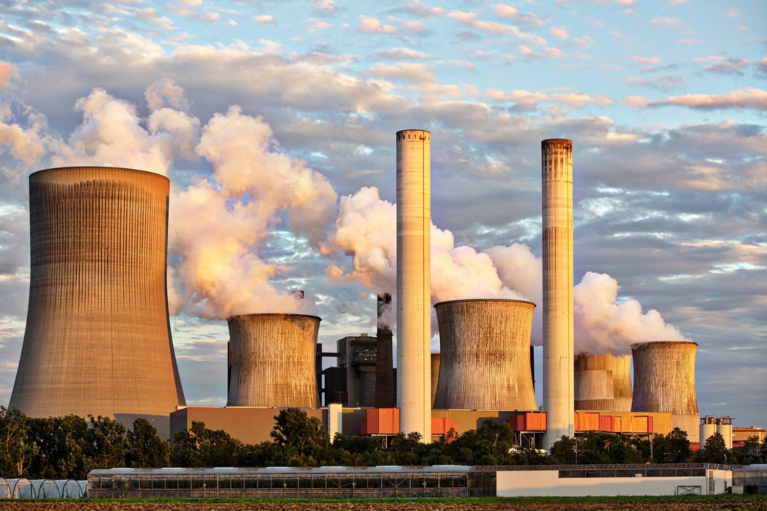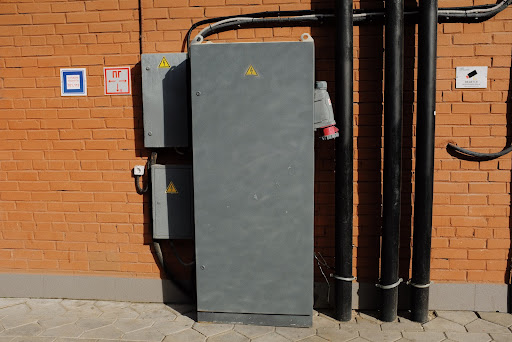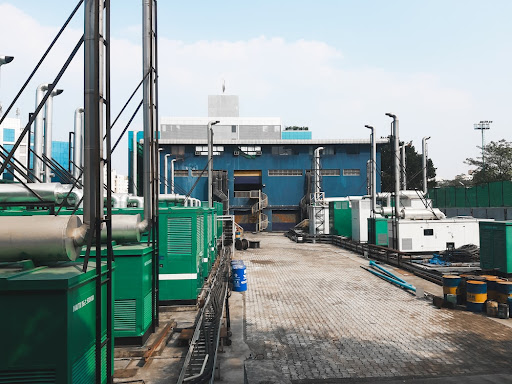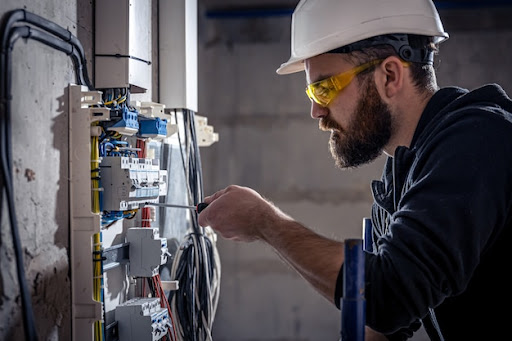Have you heard of engine block heaters? Engine heaters are for diesel and natural gas generators, as room heaters are for humans in the cold winter season. They warm up your generator’s engine to get it started and running smoothly during outages.
The NFPA regulations require all standby generators to operate within ten seconds following a power outage. However, extreme cold can affect your generator’s coolant and engines, slowing their functions.
An engine block heater solves this problem by maintaining the coolant’s temperature between 100 and 120 degrees Fahrenheit. This optimal temperature ensures your generator stays compliant and prevents damage to engine components due to a cold start.
Image: Industrial power cabinet installed on street
What is an Engine Block Heater?
An engine block heater is an electrical device designed to warm the engine blocks and internal fluids before starting the engine.
Engine oils can thicken during cold weather, making it harder for the generator to function. If you forcibly start the engine in a cold climate in such a condition, it can cause severe wear and tear to its parts.
Engine block heaters ensure that your standby generators maintain a temperature between 100 and 120 degrees Fahrenheit. At higher temperatures, the engine oil becomes less viscous and flows easily, providing better lubrication to the engine parts.
This way, the block heater ensures your generator starts faster while reducing the friction that comes with cold starts. It can also save fuel and emissions by helping the engine reach its optimal operating temperature more quickly.
Types of Engine Block Heaters
Not all engine block heaters are the same. Some heat the engine coolant directly, while others heat the engine. Some are attached to the exterior of the engine block, while others are incorporated into the engine compartment. Before deciding on a block heater that best suits your needs, you need to understand how each type works.
Here are some popular types of engine block heaters for generators:
- Immersion heaters are installed in the oil sump of the engine and heat the engine oil directly. They are typically powered by electricity and are available in different sizes and wattages to match the engine.
- Magnetic Heaters are attached outside the engine block and use a magnetic field to heat the metal and internal engine components. Easy to install and remove, they are ideal for smaller engines.
- Dipstick Heaters are inserted into the engine instead of the regular engine oil dipstick. They consist of an elongated heating element that directly heats the oil.
- Circulation Heaters use a pump to circulate warm coolant through the engine block and heat it indirectly. They are typically more complex to install than other engine block heaters but are effective for heating larger engines.
- Cartridge Heaters are inserted directly into the engine block and heat the metal from the inside. They are usually used for high-performance engines.
Image: power plant and generators
How Do You Use an Engine Block Heater?
The working and installation process can vary across heater types. Magnetic heaters are easier to install, while circulation heaters should be professionally installed. You should choose a heater based on your need and DIY comfortability.
Once you install the heater, connect it to a grounded electric outlet using a heavy-duty extension cord. Ensure that the cord is rated for outdoor use and can handle the wattage of the heater.
Per the manufacturer’s instructions, turn on the block heater and allow it to run for a few hours. The timing may vary depending on the type of heater and the outside temperature. As a rule of thumb, leave your block heater plugged in for 1 to 2 hours before starting your engine.
Most block heaters are connected to a constant electric supply or have a thermostat included to maintain and regulate engine coolant and temperature. It is important to disconnect the heater when you start running the engine.
Some generator block heaters may be designed to operate using an internal battery, but this is less common.
How Do You Choose the Right Engine Block Heater?
There are several things to consider, from engine type to heater durability and cost, before you choose an engine heater. Here are a few tips to help you make the best pick:
- Know your generator type first. Is it a diesel-powered generator or natural gas generator? The heater requirement will be different for each type.
- Check the generator’s label or owner’s manual to determine your engine size and type. It will help you determine the size of your heater compatible with your generator.
- If you live in a very cold region, consider choosing a heater with high heating capacity.
- In harsh climates, you may also want to consider an engine block heater with a built-in thermostat or timer that helps regulate the temperature.
- Ensure that the heater fits your generator’s engine block and is compatible with your power source (e.g., 120V AC, 240V AC).
- Finally, ensure that you buy a high-quality heater from a reputable brand.
Once you choose the right heater, install the heater correctly and safely, keeping the generator safety tips in mind. If you are not comfortable installing the block heater yourself, it’s best to have it professionally installed.
How to Maintain an Engine Block Heater
Image: Technician inspecting switchboard and connecting cable.
Like all electric devices, an engine block heater requires proper care and maintenance to stay efficient for a long time. You can also pair your block heater with an engine warming blanket for optimal results in freezing temperatures. Here are a few ways to maintain the heater to ensure its longevity:
Check the Heater Regularly
Inspect the block heater weekly or as needed for signs of damage, such as cracks or frayed cords.
Clean and Flush the Heater
Clean the block heater every two years by draining and flushing it to remove dirt and debris that may have accumulated.
Use Soft Water
Hard water can cause scaling, affecting the block heater’s efficiency. Use soft water instead to prevent scaling.
Mix Antifreeze Properly
The improper blending of antifreeze can lead to weather-related issues or scaling. Follow the manufacturer’s instructions for blending antifreeze correctly. The additives in antifreeze also help prevent corrosion and rust in the engine block and cooling system.
Replace Rubber Hoses
Replace the rubber hoses on the block heater every three years to prevent leaks and ensure optimal performance.
The Takeaway
This is all the important information you need regarding generator engine block heaters. As you can see, having a block heater can increase your generator’s efficiency while protecting the engine from damage due to cold starts. You can follow the generator manual to select and install the right block heater or seek the help of a professional.
Still, several aspects of generator engine block heaters may require detailed discussion. If you’re looking for a reliable and high-quality engine block heater for your diesel generator or have any questions, contact Central State Diesel Generators.
FAQs about Engine Block Heater
1.Do I need an engine block heater for my generator?
An engine block heater can be a worthwhile investment if your business is located in an area with cold winters and freezing temperatures. Cold weather can make it difficult for a generator to start, and a block heater can help alleviate this issue. Experts advise installing an engine block heater if your generator is exposed to temperatures of 60 degrees Fahrenheit or less.
2.Can I install an engine block heater myself, or do I need a professional?
Most engine block heaters can be installed with basic tools and some mechanical knowledge. However, if you’re not comfortable working on engines or have never installed a block heater before, it’s best to seek professional help so that the heater is installed correctly and safely.
3.How long should my block heater be plugged in before starting the generator?
It’s generally recommended to plug in the engine block heater for at least two to three hours before starting it up in cold weather. This allows enough time for the engine block and coolant to warm up sufficiently.
4.Can I leave my engine block heater plugged in all the time?
While it’s technically possible to leave your engine block heater plugged in all the time, it’s not recommended. Doing so can increase your energy bills and overall operating costs and may shorten the lifespan of the engine warming heater. It’s best to use a timer or thermostat to automatically turn them on and off to maintain the desired temperature.
5.How much energy does a generator engine block heater use?
An engine block heater for a generator can consume anywhere from 400 to 1500 watts of electricity per hour, depending on the heater’s wattage and the outside temperature. You should follow the manufacturer’s recommendations regarding the proper use of the heater to avoid wasting energy and increasing your electric bill.





